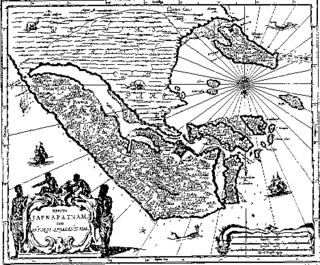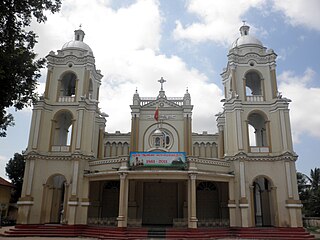Related Research Articles

The Jaffna kingdom, also known as Kingdom of Aryachakravarti, was a historical kingdom of what today is northern Sri Lanka. It came into existence around the town of Jaffna on the Jaffna peninsula and was traditionally thought to have been established after the invasion of Kalinga Magha from Kalinga in India. Established as a powerful force in the north, northeast and west of the island, it eventually became a tribute-paying feudatory of the Pandyan Empire in modern South India in 1258, gaining independence when the last Pandyan ruler of Madurai was defeated and expelled in 1323 by Malik Kafur, the army general of the Delhi Sultanate. For a brief period in the early to mid-14th century it was an ascendant power in the island of Sri Lanka, to which all regional kingdoms accepted subordination. However, the kingdom was overpowered by the rival Kotte kingdom around 1450 when it was invaded by Prince Sapumal under the orders of Parakramabahu VI.

The Thanjavur Nayakdynasty were the rulers of Thanjavur in the 15th and 17th centuries. The Nayaks, who belonged to the Telugu-speaking Balija social group were originally appointed as provincial governors by the Vijayanagara Emperor in the 15th century, who divided the territory into Nayak kingdoms which were Madurai, Tanjore, Gingee and Kalahasthi. In the mid-15th century they became an independent kingdom, although they continued their alliance with the Vijayanagara Empire. The Thanjavur Nayaks were notable for their patronage of literature and the arts.
Karaiyar is a Sri Lankan Tamil caste found mainly on the northern and eastern coastal areas of Sri Lanka, and globally among the Tamil diaspora.

Cankili I, also known as Segarasasekaram, is the most remembered Jaffna kingdom king in the Sri Lankan Tamil history. He was active in resisting Portuguese colonial inroads into Sri Lanka. He inherited his throne via palace intrigues in which a number of heirs died under mysterious circumstances. Ultimately, he was removed from power by a local uprising that led to his son Puviraja Pandaram taking nominal power from him.
The following is a chronological overview of the history of the Karavas and Karaiyars caste of Sri Lanka and India. Both communities were historically also known as Kurukulam, meaning Kuru clan.

Cankili II, also spelled Sangili) was the last king of the Jaffna kingdom and was a usurper who came to throne with a palace massacre of the royal prince and the regent Arasa-kesari in 1617. His regency was rejected by the Portuguese colonials in Colombo, Sri Lanka. His reign was secured with military forces from the Thanjavur Nayaks and Karaiyar captains. He was defeated by the Portuguese in 1619 and was taken to Goa and beheaded. With his death the Aryacakravarti line of Kings who had ruled the kingdom for over 300 years came to an end.
Periyapillai was of one of the Aryacakravarti rulers of Jaffna kingdom who followed in the chaotic period after the death of Cankili I(1519–1561). Some sources claim that he deposed the Cankili I's son, Puviraja Pandaram as soon as Cankili I died. Others say that there was an intermediate ruler named Kasi Nainar between him and the death of Cankili I. He with the help of Thanjavur Nayak help mounted an attack on the Portuguese fort in the Mannar Island to regain territory lost during Cankili's rule but he was defeated. Due to a local uprising he lost power to Puviraja Pandaram. He is considered to be the father of the last king of the Kingdom, Cankili II and Migapulle Arachchi.

The Portuguese conquest of the Jaffna kingdom occurred after Portuguese traders arrived at the rival Kotte kingdom in the southwest of modern Sri Lanka in 1505. Many kings of Jaffna, such as Cankili I, initially confronted the Portuguese in their attempts at converting the locals to Roman Catholicism, but eventually made peace with them.

Lascarins is a term used in Sri Lanka to identify indigenous soldiers who fought for the Portuguese during the Portuguese era (1505–1658) and continued to serve as colonial soldiers until the 1930s. The lascarins played a crucial role not only in the colonial armies, but also in the success of the campaigns of the local kingdoms.

Portuguese Ceylon is the name given to the territory on Ceylon, modern-day Sri Lanka, controlled by the Portuguese Empire between 1597 and 1658.
When to date the start of the history of the Jaffna kingdom is debated among historians.
Achuthappa Nayak was the Nayaka of Thanjavur under the Vijayanagara Empire from 1560 to 1614. From 1560 to 1580, he was co-Nayaka along with his father and from 1580 to 1614, he ruled on his own. His reign was eventful and its later years were marked by conflict.
Raghunatha Nayak was the most powerful king of the Thanjavur Nayak Dynasty. He was the third ruler of Thanjavur, southern India, from the Nayak dynasty. He belongs to Balija caste. He ruled from 1600 to 1634 and is noted for the attainments of Thanjavur in literature, art, and Carnatic music.

Sinhalese–Portuguese conflicts refers to the series of armed engagements that took place from 1518 AD to 1658 AD in Sri Lanka between the native Sinhalese and Tamil kingdoms and the Portuguese Empire. It spanned from the Transitional to the Kandyan periods of Sri Lankan history. A combination of political and military moves gained the Portuguese control over most of the island, but their invasion of the final independent kingdom was a disaster, leading to a stalemate in the wider war and a truce from 1621. In 1638 the war restarted when the Dutch East India Company intervened in the conflict, initially as an ally of the Sinhalese against the Portuguese, but later as an enemy of both sides. The war concluded in 1658, with the Dutch in control of about half the island, the Kingdom of Kandy the other half, and the Portuguese expelled.

This is a bibliography of works on Sri Lanka.

Gurunagar is a coastal village in Jaffna city in northern Sri Lanka. Gurunagar is also known as Karaiyur.

Portuguese invasion of Jaffna kingdom in 1591 AD was the second expedition against the Jaffna kingdom by the Portuguese. The campaign, led by Captain André Furtado de Mendonça, started from Mannar and continued to Nallur, the capital of the Jaffna kingdom. The Portuguese captured the kingdom, killed the king, and installed Ethirimana Cinkam as the new ruler.
The Portuguese invasion of Jaffna kingdom in 1560 AD was the first expedition against the Jaffna kingdom by the Portuguese Empire. It was led by Viceroy Dom Constantino de Bragança and resulted in the capture of the capital, Nallur. The king of Jaffna, Cankili I, managed to escape and regained the capital through a pact that he made with the Portuguese. He subsequently incited a peoples' rebellion against the Portuguese, resulting in their withdrawing their forces from Nallur. The Jaffna kingdom, however, lost its sovereignty over Mannar Island and its main town, Mannar.
Kuruvita Rala was a Sri Lankan rebel leader and prince of Uva, who served as regent in the kingdom of Kandy. He was also a relation of Dona Catherina, Queen of Kandy and the guardian of her children.
Varunakulattan was a 17th-century general of Tanjore nayak, feudal lord and military commander from the Tanjore Nayak Kingdom. He led a rebellion as the military commander of Thanjavur Nayak against the Portuguese in their conquest of the Jaffna kingdom in 1619. Although the nominal king was Cankili II, Varunakulattan was described as the king of Karaiyars, and wield the real power in the Jaffna Peninsula.
References
- Sabaratnam, T.M (2010). Sri Lankan Tamil Struggle, Chapter 5: Tamils lose sovereignty. United States: sangam.org. Accessed 25-02-2016
- Vriddhagirisan, V (2007). Nayaks of Tanjore. New Delhi: Asian Educational Services. pp. 6, 80–81, 91–92. ISBN 978-8120609969.
- Abeysinghe, Tikiri (2005). Jaffna under the Portuguese. Colombo: Stamford Lake. p. 66. ISBN 955-1131-70-1 .
- Gnanaprakasar, Swamy (2003). A Critical History of Jaffna. New Delhi: Asian Educational Services. p. 122. ISBN 81-206-1686-3.
- Pieris, Paulus Edward (2000). Ceylon and the Portuguese, 1505-1658. New Delhi: Asian Educational Services. p. 290. ISBN 81-206-1372-4.